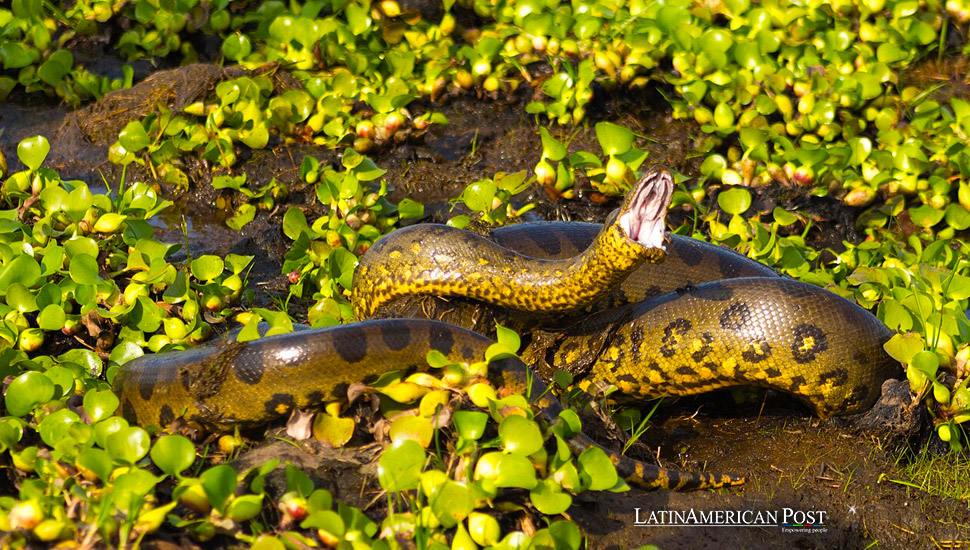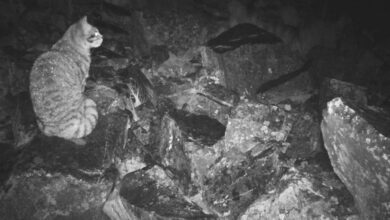The Untold Story of the Latest Andean Anaconda’s Discovery

Recent research has uncovered the existence of a previously unknown species of anaconda in South America, the Northern Green Anaconda (Eunectes akayima). This discovery not only challenges our understanding of these aquatic giants but also highlights the urgent need for conservation efforts in their rapidly deteriorating habitats.
Anacondas, belonging to the genus Eunectes, are a group of aquatic snakes native to the eastern slopes of the Andes in South America. These large-bodied serpents, known for their adaptability to an aquatic lifestyle, inhabit the lowland rivers and wetlands of the region. With nostrils and eyes positioned dorsally on their heads, anacondas are perfectly adapted to their environment, blending seamlessly with aquatic vegetation.
Until recently, scientists believed that South America was home to a single species of green anaconda, Eunectes murinus, recognized as the heaviest snake in the world. However, groundbreaking research has revealed the existence of a second species—the Northern Green Anaconda, Eunectes akayima. This discovery was made through a study examining the genetic relationships within the genus Eunectes across nine countries. The results showed that what was previously thought to be a single species, Eunectes murinus, actually comprises two distinct species, genetically divergent yet nearly identical in appearance.
The newly recognized Eunectes akayima inhabits the northern regions of South America, including Ecuador, Venezuela, Trinidad, Guyana, Suriname, and Colombia. This species also shares territory with its southern counterpart, Eunectes murinus, in places like French Guiana, where they sometimes dwell on opposite banks of the same river. Despite their close proximity, these two species never interbreed, further solidifying their distinctiveness.
The study, which utilized genetic data from four recognized anaconda species, highlighted the significant genetic divergence between the Northern and Southern Green Anacondas. The researchers identified two distinct clades within Eunectes murinus, leading to the recognition of Eunectes akayima as a separate species. The discovery of this cryptic species is a monumental step in herpetology, reshaping our understanding of these elusive reptiles.
Cultural Significance and Scientific Naming
The name Eunectes akayima carries deep cultural significance, particularly for the Indigenous Carib people who have lived in northern Venezuela for centuries. The word “anaconda” in various Cariban languages is a variant of akayima, okoyimo, or okoimo. In these languages, “akayi” or “okoyi” means “snake,” and the suffix “-ima” or “-imo” signifies “large.” However, this largeness does not necessarily refer to physical size but rather denotes a category of being, something grander and more profound. The literal translation of akayima is “The Great Snake.”
This cultural context played a crucial role in naming the new species. The researchers acknowledged the heritage and beliefs of the Indigenous people who share their lands with these magnificent creatures by adopting their word for anaconda as the species’ name. The pronunciation of akayima has been carefully noted to respect its linguistic roots, ensuring that the name honors the Cariban language and its speakers.
In contrast, the name Eunectes murinus has been retained for the Southern Green Anaconda to promote taxonomic stability and avoid confusion. The decision to differentiate these species underscores the importance of cultural and scientific collaboration in taxonomy.
Before this discovery, the genus Eunectes was known to include four species: Eunectes murinus (the green anaconda), Eunectes beniensis (the Beni anaconda), Eunectes deschauenseei (the dark-spotted anaconda), and Eunectes notaeus (the yellow anaconda). Each species occupies a unique ecological niche within South America’s vast and diverse landscape. The green anaconda, Eunectes murinus, is the largest of these species, inhabiting tropical regions across the continent, including the basins of the Amazon, Esequibo, and Orinoco rivers. The other species, though more minor, are similarly distributed within or adjacent to the range of Eunectes murinus.
Ecological Threats Facing the Amazon
The discovery of the Northern Green Anaconda occurred during a rare and extraordinary expedition. The research team, led by Professor Bryan Fry from the University of Queensland, was invited by the Waorani people, an Indigenous group in Ecuador, to explore the region and collect samples from a population of anacondas rumored to be the largest. The Waorani, considering these snakes sacred, guided the scientists on a 10-day journey through the dense jungle.
Traveling by canoe, the team navigated the river systems and located several anacondas lurking in the shallows, poised to ambush their prey. Among these was a female anaconda measuring an astounding 6.3 meters (20.7 feet) in length. The Waorani people shared accounts of even larger anacondas, some reportedly exceeding 7.5 meters (24.6 feet) in length and weighing around 500 kilograms.
The discovery of Eunectes akayima adds a new chapter to the story of South American wildlife and raises concerns about the ecological threats facing the Amazon. Eunectes akayima is believed to have diverged from its southern relative, Eunectes murinus, nearly 10 million years ago. The genetic difference between the two species is substantial, with a 5.5% divergence, a figure that underscores the significance of this discovery. To put this in perspective, humans and chimpanzees differ by only about 2%.
Despite the excitement surrounding this discovery, it comes at a time when the Amazon faces severe ecological threats. Deforestation, driven by agricultural expansion, has resulted in an estimated 20-31% habitat loss, which could impact up to 40% of the Amazon’s forests by 2050. Habitat degradation from land fragmentation, caused by industrialized agriculture and pollution from oil extraction, further exacerbates the problem. Additionally, forest fires, drought, and climate change pose ongoing threats to the region’s biodiversity.
The Northern Green Anaconda and other species that share this remote ecosystem face significant challenges. The loss and degradation of their habitats could have devastating effects, not just on these snakes but on the entire ecosystem that depends on the health of the Amazon rainforest.
The Urgency of Conservation and Further Research
The discovery of Eunectes akayima is a testament to the importance of ongoing research and conservation efforts in the Amazon. As Professor Fry emphasized, identifying a new species is thrilling but highlights the urgent need to protect these endangered ecosystems. The Amazon is not just home to iconic species like the anaconda; it is a vital component of the Earth’s ecological balance.
One of the most pressing issues identified by the researchers is the impact of heavy metal pollution from oil spills on the fertility and reproductive biology of anacondas and other keystone species in the Amazon. This pollution, alongside other environmental threats, could have long-term consequences for the survival of these species. The research team plans to focus their following study on investigating how petrochemicals from oil spills affect the Amazon’s wildlife, including the newly discovered Northern Green Anaconda.
The plight of the Northern Green Anaconda is a microcosm of the broader environmental crisis facing the Amazon. Human activities constantly threaten the region’s biodiversity, and without immediate action, we risk losing countless species before they are fully understood.
The discovery of Eunectes akayima serves as a reminder of the rich biodiversity that still remains to be explored in the Amazon, but it also underscores the fragility of this ecosystem. Conservation efforts must be intensified to protect these rare and majestic creatures and to preserve the ecological integrity of one of the world’s most important natural landscapes.
Also read: One Hundred Years of Solitude: Rediscovering Ecuador’s Lost Frog
The study detailing the discovery of Eunectes akayima has been published in the journal Diversity, offering a comprehensive account of the genetic research that led to this groundbreaking identification. As scientists and conservationists continue to explore the depths of the Amazon, the hope is that increased awareness and action will help safeguard this unique and irreplaceable ecosystem for future generations.





